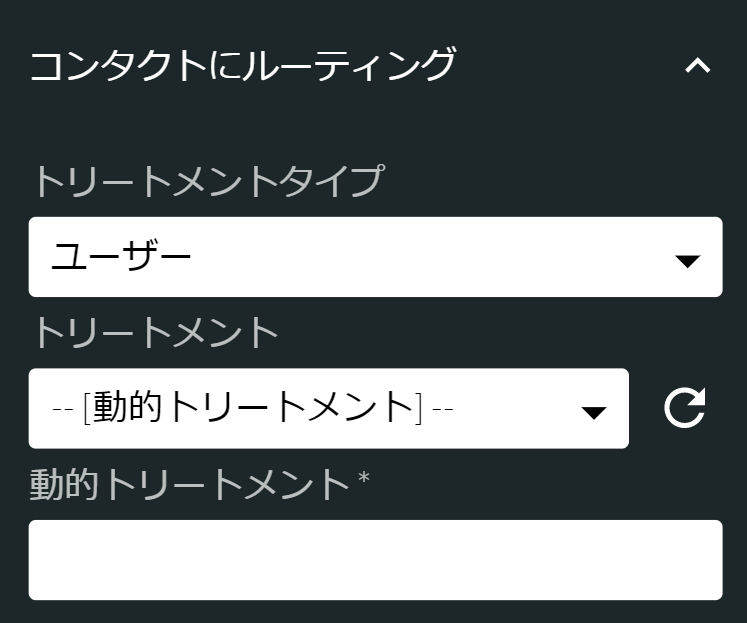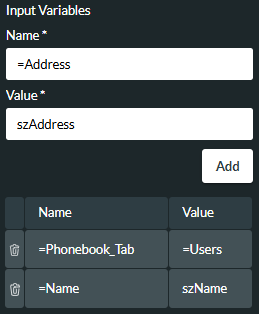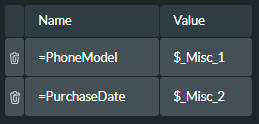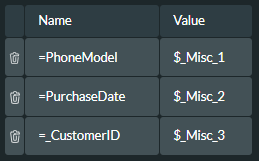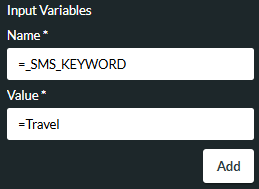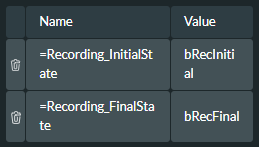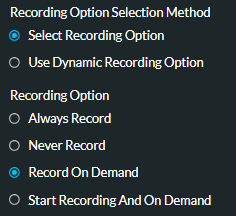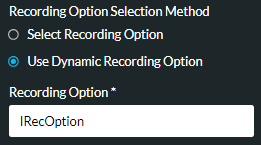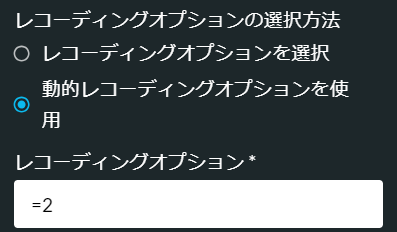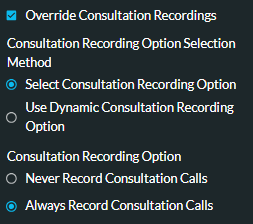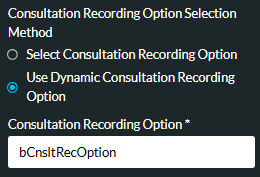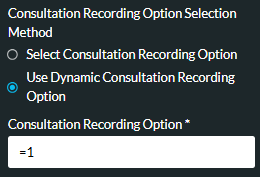Route to Contact
|
Routes a communication to a user or treatment (such as a queue or hunt group) configured in storm UC and CONTACT. |
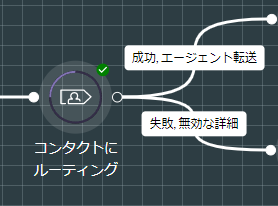
Note: when routing a web chat or social media interaction, execution continues along the cell when the interaction has ended in storm UC rather than immediately upon routing to UC.
Properties
Route to Contact Section
|
Option |
Description |
|
Treatment Type |
Select a storm UC treatment type. |
|
Treatment |
Select the individual user or treatment. For a 'Voicemail Retrieval' treatment type, you can enter the name or username of the user (prefixed by =) to whose voicemail box the call should be routed. If you do not, the caller will be prompted for a mailbox extension on the call. For a 'Callback Queue' treatment type, you must enter the callback number for the queued caller. For all treatment types except 'Voicemail', select '[Dynamic Treatment]' to use a variable value rather than a fixed entity. The variable may contain the name of the treatment, its extension, its ID, or a value obtained from a database lookup.
|
|
This applies when the treatment type is 'Contact Queue'. |
|
|
This applies if your contact centre is configured to use the queue prioritisation feature and the treatment type is 'Contact Queue'. Use this to assign an initial priority value to the caller as they enter a queue that has been configured to route callers based on entrant priority values. This must be provided as a literal preceded by =, or a variable of type integer. Note: routing based on entrant priority is not enabled by default and is available on request. |
|
|
This applies when the treatment type is 'User' or 'Hunt Group'. Select this option if you want calls to the selected user or hunt group to ring the destination phone even when the availability status of the user (or a user in the hunt group) is 'Available (Internal Only)'. Normally, storm deems all calls routed to users from a FLOW script to be external even if the script was invoked by calls from other users or SIP trunks in your organisation. Selecting this option ensures that such calls are treated as internal. |
|
|
This applies when the treatment type is 'Call Park'. Enter the extension number assigned to the call park from which to retrieve any calls that have been parked by storm users (as a literal value preceded by =, or a string variable). For a valid call park extension, the call is answered by the call park service, allowing the caller to pick up the parked call. |
Inputs Section
Use this section to build a list of variables to pass to DTA agents or to a CRM application.
|
Option |
Description |
||||||||||||||||||||||||||
|
Store variables against Recording |
Select this to store the input values against the call recording for visibility in storm RECORDER fields. These fields must be configured by Content Guru. Contact your local support representative for more information. |
||||||||||||||||||||||||||
|
Use this to specify the URL for a web page that will appear in a separate browser window or tab for DTA agents handling the communication. Either specify the URL directly (preceded by '='):
Or by using a string variable:
|
|||||||||||||||||||||||||||
|
The language in which the interaction is expected to take place. This determines the language used to select prompts, write transcriptions, and provide real-time transcription services. The language must be specified using the correct IETF language tag. See the appendix topic Supported IETF Language Tags for a list of supported language tags. The specified value will override the language settings configured in storm UC and CONTACT. |
|||||||||||||||||||||||||||
|
If relevant, select the template variable to be used to provide a pre-populated email template to the DTA agent. |
|||||||||||||||||||||||||||
|
In the Name field, enter a label for the value to display to the agent or the parameter name to be used by a CRM application. In the Value field, provide the variable. Click ADD to add the name and value pair to the list below. If your agents are DTA Phonebook users, you can use these fields to force a particular Phonebook tab to be displayed in the DTA Phonebook panel when the call is routed to an agent (provided the agent has been granted access to the Phonebook tab). To do this, type '=Phonebook_Tab' in the Name field and then specify the name of the tab to open in the Value field (see illustration below). You can reorder the variables by clicking and dragging an item to the location indicated by the black line.
These input variable fields can be used to identify information to be displayed in an agent script. (Agent scripts allow agents on voice calls to read on-screen text in the DTA. See the storm UC and CONTACT Configuration Guide for more information.) The name assigned to a field here must match the name given to the variable used in the agent script.
To identify a variable that is only to be used in an agent script, prepend the name given to it with an underscore character (as shown below for the Customer ID variable).
For a text-based or OUTBOUND preview communication, you can substitute the message data that is passed to DTA agents with alternative values. This is useful if, for example, you wish to present alternative information such as an amended origination or message. For message type 'SMS Record':
For message type 'Email Record':
For OUTBOUND dialler campaigns that use preview pacing profiles:
Use the value to substitute in the Value field. For example:
|
Outputs Section
Use this section to build a list of variables that store data returned to FLOW from DTA agents.
Note: these variables are relevant to voice interactions only.
|
Option |
Description |
||||||||||||||||
|
In the Name field, enter a label to display to the agent. In the Value field, provide the variable to store the agent-entered value. Click ADD to add the Name and Value pair to the list below. Each entry is presented as an editable field to the agent in DTA. The value saved by the agent populates the variable, which is available for further post-call processing.
You can reorder the variables by clicking and dragging an item to the location indicated by the black line. If your agents are permitted to start and stop call recordings in DTA, then you can store these actions in output variables for reporting in the storm VIEW application. For example:
Note: this feature must be enabled by Content Guru. Contact your local helpdesk if required. The following statuses are supported:
|
|||||||||||||||||
|
Agent Exit Code |
Applies only when the selected treatment has Enable FLOW Transfer enabled in storm UC and CONTACT. Enter a string variable to store the DTMF digits (for example, a customer ID) entered by the user. |
||||||||||||||||
|
User ID |
Enter an integer variable to store the user ID of the last user who spoke to the caller before the call returned to the script. This variable is populated if either the Success or Agent Transfer exit routes are used. |
||||||||||||||||
|
Username |
Enter a string variable to store the user name of the last user who spoke to the caller before the call returned to the script. This variable is populated if either the Success or Agent Transfer exit routes are used. |
||||||||||||||||
|
Enter a variable (integer or float) to store the length of time (in seconds) the caller spent on the call actually talking to agents. If the caller spoke to more than one agent, the length of time is across all agent conversations. Note: if you use an integer variable, any decimal value returned using this field is rounded down to whole seconds. |
|||||||||||||||||
|
Last Agent Talk Duration |
Enter a variable (integer or float) to store the length of time (in seconds) the caller spent talking to the agent (if they spoke only to one agent); or the length of time they spent talking to the last agent, where they spoke to more than one. Note: if you use an integer variable, any decimal value returned using this field is rounded down to whole seconds. |
Recording Options Section
Recording options determine the call recording mode of routed calls. Use this section if you want to set the mode based on caller input or preferences available to this script rather than use the call recording mode configured in storm UC and CONTACT. The overrides configured in this action cell continue to apply when storm users transfer calls to other queues.
Note: this section applies to voice interactions only, and where the selected Treatment Type is 'User', 'Hunt Group', 'Supervised Group', or 'Contact Queue'.
|
Option |
Description |
|||||||||||||||
|
Override Default Recording Settings |
Select this option if you want this action cell to override the recording settings configured in storm UC and CONTACT. |
|||||||||||||||
|
Recording Option Selection Method |
Either choose Select Recording Option or Use Dynamic Recording Option. On choosing the Select Recording Option, select one of the four recording options. (See table in Recording Option below for the meaning of each option.)
On choosing Use Dynamic Recording Option, specify a variable of type integer in the the Recording Option field:
The Recording Option field also supports integer values of between 0 and 3 preceded by = and corresponding to the four available recording options. (See table in Recording Option below for the meaning of each value.)
|
|||||||||||||||
|
Recording Option |
Use one of the following four recording options:
|
|||||||||||||||
|
Available for all Recording Option settings except '0 - Never Record'. Select this option to control whether consultation calls from routed calls are initially recorded. Users will still be able to start and stop the recording of consultation calls if the Recording Option setting is '2 - Record On Demand', or '3 - Start Recording And On Demand'. Either choose Select Consultation Recording Option or Use Dynamic Consultation Recording Option. On choosing the Select Consultation Recording Option, select one of the two options 'Never Record Consultation Calls' or 'Always Record Consultation Calls'.
On choosing Use Dynamic Consultation Recording Option, specify a variable of type Boolean in the Consultation Recording Option field:
The Consultation Recording Option field also supports values of 0 and 1 preceded by = and corresponding to the two options 'Never Record Consultation Calls' and 'Always Record Consultation Calls', respectively.
|
Routing to a Preferred Agent
Note: see the description of the Get Last Interaction action cell for a description of how a FLOW script is constructed to route an incoming message to the agent who last dealt with that particular contact.
If you select ‘Contact Queue’ as your destination type, additional fields are available to allow you to route the incoming communication to a preferred agent.
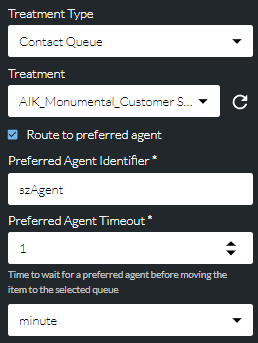
Select the Route to preferred agent check box and then populate the Preferred Agent Identifier field with a string variable that will be used to identify the agent to which the communication should be routed. The system uses the value in this variable to search for a match, first, for the agent’s user ID or extension (if the first three characters of the string are ‘ext’); then for their full name; and then for their username. If the FLOW script is for an OUTBOUND campaign, this field can be used to identify a particular agent to be targeted to handle the communication.
Use the first drop-down list in the Route to Contact Section of the properties to select the queue (or drag a variable into the field provided to identify the queue at run-time) to which the incoming communication should be routed if the agent is unavailable. Use the Preferred Agent Timeout drop-down lists to specify how long the system should attempt to deliver the message to the agent before routing it to the queue instead (you can set a timeout of up to 14 days.)
See Routing an Interaction to the Same Agent for an example.
For voice calls that are routed in this way:
- Once the preferred agent has been identified, while the system is attempting to connect them to that agent, the caller will not hear any of the repeating information messages played to callers in the queue to which the call was originally routed. (They will, however, still hear any hold prompts and music configured for the queue.)
- If the treatment-level timeout assigned to the original queue is shorter than the timeout set in the Route to Contact action cell, the treatment-level timeout set for the original queue is applied to the call.
- If the treatment-level timeout assigned to the original queue is longer than the timeout set in the Route to Contact action cell, the call is returned to the original queue once the action cell timeout has been reached. The original queue's treatment-level timeout then applies, and is measured from the point at which the call first started waiting to be connected to the preferred agent.
You can also populate the Preferred Agent Identifier field with the @IM Last User ID system variable to ensure that a guest who decides to restart a web chat conversation after it ended due to inactivity is routed to the same agent.
Exit Points
|
Exit Point |
Description |
|
Success |
This is taken if the communication is routed successfully. It is also taken if the communication routes back to the script (see the Agent Exit Code parameter) but there is no 'Agent Transfer' route. |
|
Failure |
This is taken for a communication that has not been routed despite forwarding rules and extended configuration overflow rules having been attempted. It is also taken for an OUTBOUND call when the outbound queue’s maximum wait time is reached. |
|
Invalid Details |
This is taken when the second drop-down list in the Route to Contact Section of the properties is set to '[Dynamic Treatment]' and the system cannot identify the intended target. |
|
Agent Transfer |
Relevant for voice interactions only. This is taken when an agent enters the defined DTMF sequence for transferring the call back into the script. See the Agent Exit Code parameter. |
|
Relevant for voice interactions only. This is taken when the caller requests a callback. Note: this applies to voice calls that are routed to a treatment of type 'Contact Queue' and where the Enable Callback? option is enabled on the treatment in storm UC and CONTACT. |
|
| This is taken if an internal error occurred. |
